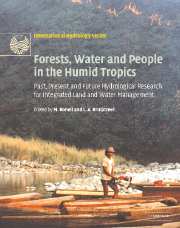 Forests, Water and People in the Humid Tropics
Forests, Water and People in the Humid Tropics Book contents
- Frontmatter
- Contents
- List of contributors
- Foreword
- Preface
- Acknowledgements
- Symposium and Workshop
- Introduction
- Part I Current trends and perspectives on people–land use–water issues
- Part II Hydrological processes in undisturbed forests
- Part III Forest disturbance, conversion and recovery
- Part IV New methods for evaluating effects of land-use change
- Part V Critical appraisals of best management practices
- Conclusion: Forests, water and people in the humid tropics: an emerging view
- Plate section
Part IV - New methods for evaluating effects of land-use change
Published online by Cambridge University Press: 12 January 2010
- Frontmatter
- Contents
- List of contributors
- Foreword
- Preface
- Acknowledgements
- Symposium and Workshop
- Introduction
- Part I Current trends and perspectives on people–land use–water issues
- Part II Hydrological processes in undisturbed forests
- Part III Forest disturbance, conversion and recovery
- Part IV New methods for evaluating effects of land-use change
- Part V Critical appraisals of best management practices
- Conclusion: Forests, water and people in the humid tropics: an emerging view
- Plate section
Summary
SUMMARY
This part contains eight chapters dealing with new methods to detect, evaluate or predict the hydrological effects of land-use change. They range from remotely sensed observations of terrain and vegetation characteristics, through statistical analysis of trends in streamflow data, to various model approaches simulating hydrological and related processes such as erosion and deposition at the hillslope to catchment scale. Also examined is the usefulness of isotope tracers as a tool to enhance hydrological process understanding under humid tropical conditions. The final chapter explores the possibility of using aquatic organisms as an indicator of water quality.
Held and Rodriguez present an overview of new remote sensing technologies for the derivation of key forest and terrain attributes. These can be divided into three groups: (i) those relevant to assessment (vegetation cover, forest type and structure, age of regenerating forest, and fire history); (ii) indicators of stress; and (iii) those more directly relevant to hydrology (terrain attributes, soil characteristics, photosynthesis and transpiration). Airborne systems (balloons, planes) allow for higher spatial resolution image collection than satellite systems and contain sensors (e.g. laser detection and ranging, LDR) capable of collecting data under cloud cover, which would make them particularly useful in (tropical) areas experiencing frequent cloud. Satellite systems provide a more stable platform for operational data collection and have the advantage of covering larger areas more rapidly at a lower cost per unit area.
- Type
- Chapter
- Information
- Forests, Water and People in the Humid TropicsPast, Present and Future Hydrological Research for Integrated Land and Water Management, pp. 671 - 674Publisher: Cambridge University PressPrint publication year: 2005


